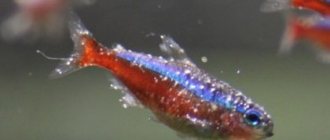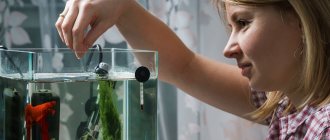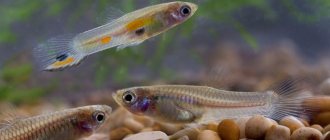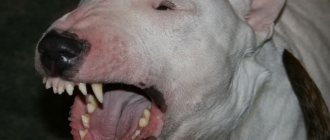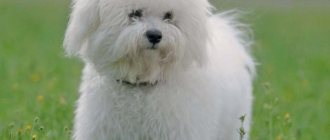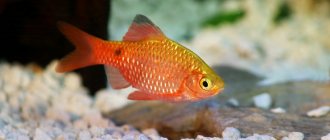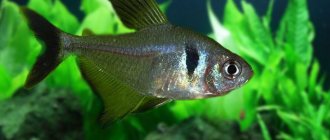Main types of aquarium fish
In nature, there are a myriad of fish species, which are constantly replenished with hybrids and selected specimens. All representatives are divided into groups united by common characteristics.
| Family | Description | Representatives |
| Atherine | Elongated body shape with an elongated head. Color is multi-colored. The food is varied (vegetation, livestock, dry food). There are nuances in care that should be taken into account when preparing the aquarium. Peace-loving. | Red, two-color, Black Sea, Ladigesi. |
| Carp | The body is covered with scales, monochromatic. Omnivores (dry, frozen, live, canned). Unpretentious, suitable for beginners. They live in flocks. The character is flexible and gets along easily with other representatives. | Goldfish, zebrafish, labeo, barb, cardinal. |
| carp-toothed | Bright, colorful small fish (less than 10 cm). The diet consists of live food. There are no difficulties in the content. Neighbors are chosen that are large and live at other levels in the aquarium. There is an aggressive attitude. | Notobranchius: gunther, rakhova, jubbie, courthouse; Afiosemions: amieta, striatum, two-stripe, southern, filamentosum, gardner. |
| Labyrinthine (creeper-shaped) | They got their name due to their respiratory organ, which helps obtain oxygen from the atmosphere. Oblong body, compressed at the sides, small head. Multicolor representatives. The diet consists of 30% live food, the rest is omnivorous. They adapt to any living conditions, the main thing is access to oxygen. Each species has its own reaction to its neighbors. | Pineapple, cockerel, gourami, lalius, labiosa. |
| Poeciliaceae | Small fish live in schools. Wide variety of colors. The diet contains fiber. Not demanding on the maintenance of the aquarium. Suitable for beginners. There are peace-loving and aggressive representatives. | Guppies, swordtail, mollies, platies, girardinus. |
| Pomacentral | They have an oval body with flattened sides. Variegated multi-colored color. They are divided into those that feed on plants and live food. They love to feast on polyps. Whimsical fish. They are aggressive towards members of their own species and are indifferent towards others. | Amphiprion, chrysipterus, zebra dascillus, dascillus, garibaldia, clownfish. |
| Rainbows | Large schooling fish. The body is long, laterally compressed. They can be single-color (red, brown, olive) or two-color (blue and yellow). They feed on plant and animal foods. There are peculiarities in care. Peace-loving. | Melanothenia: Boesman, Parkinson's, three-stripe, neon, turquoise. |
| Catfish | Covered with skin, some representatives have a protective layer of bone plates. The sides and fins are equipped with spines for protection, and the head has whiskers for exploring the environment. The body is oddly shaped. The color is varied, mainly gray, brown, dark tones. They feed on leftover food and are herbivores. Sometimes there are predatory representatives. They are not demanding in terms of care and are considered the “orderlies” of aquariums. They are not aggressive, but can attack relatives. They are threatened by other large fish. | Agamix, pterygoplichthus, ancistrus, corydoras. |
| Characinaceae | The family has great diversity, from the smallest to the giants. There are pale and bright individuals. The diet includes everything, depending on the species. There are herbivores and carnivores. There are certain requirements when setting up an aquarium and maintaining it. Neighbors are treated differently. | Neon, erythrozonus, ternetia, ornatus, serpas, tetra. |
| Cichlids | One of the largest species of vertebrate fish. The size and shape of the body have a wide range of changes. These are mainly medium-sized fish with an oval body and pressed sides. The color is rich and bright. Omnivores (carnivores, herbivores, mixed diet). Care requires compliance with certain conditions to create a comfortable living environment. The character is peaceful, sometimes cocky. Some species can be aggressive. | Apistograms: ramiresi, Bolivian butterfly; Agassian, cockatoo; American: angelfish, discus, meeka, diamondback, black-striped; African: frontosa, lionhead, johani. |
Formosa
Formosa are small aquarium fish from the Poeciliidae family. The size of the male does not exceed 2 cm, the female – 3.5 cm. The color is silver-gray, there is a wide horizontal black stripe on the sides, and a black spot on the dorsal fin.
They contain Formosa in schools of 10 or more in aquariums with a volume of 20 liters or more. The fish are unpretentious, preferring a temperature of 22-26°C, pH 6.5-7.5 and dH up to 15°. Frequent water changes are not required, but the reservoir must have good filtration. Formosa can live in brackish water. The species loves bright lighting and thickets of plants, prefers to stay in the upper and middle layers of water. Formosa fish are capable of jumping out of the tank, so the aquarium must be covered with a lid.
TOP 35 aquarium fish
Popularity includes the prevalence of the species, ease of care, maintenance, breeding, and accessibility. When choosing instances, the compatibility factor should be taken into account. The list below includes fish that are in demand.
Ancistrus
The smallest of the aquarium catfish. Its inconspicuous appearance does not reduce the merits of this fish, since it is a cleaner that actively maintains the balance of the biological environment of the reservoir.
Stickers have an unusual mouth structure in the form of a suction cup. Thanks to it, they feed on the remains of algae and collect them from the walls. Unpretentious in care.
Temperature range +20…+28 °C, pH 6.0-7.3. Hiding in snags. Herbivores do not require additional food. Easy to breed. The downside is that they chase small fish and can harm scaleless ones. The 80 liter aquarium is designed for a couple of catfish. Beginners can safely get such pets.
Read more in the article about Ancistrus catfish.
Astronotus
Powerful oval body with a large head and large thick lips. The size of the fish in an aquarium is 20-25 cm, in nature they grow up to 35 cm. The color range is varied: from red to marble.
Astronotus are kept in pairs in a large aquarium. They are unpretentious in food, omnivorous, but prefer animal food (earthworms, shrimp, mussels, grasshoppers, small fish like guppies). It is added to the diet with high-quality dry food.
Choose a large aquarium (from 400 liters per couple). The bottom is lined with sand. If vegetation is added, then with hard leaves.
Temperature in the range of +22…+26 °C, pH 6.5-7.5. Once a week, change 20% of the water and clean the soil from food debris. The container is equipped with aeration and kept closed so that the fish do not jump out. They can get along with other species, but will require a larger tank. By nature they are predators and can attack; they choose large neighbors. Not suitable for beginner aquarists.
Barbus
Small schooling fish up to 12 cm long with an elongated oblong body and variegated color. Several representatives are placed in a spacious aquarium at once. Capable of existing at temperatures of +20...+25 °C, pH 6.0-8.0.
Little algae is planted, only as a shelter. They love to swim and need space. The soil is filled with natural dark soil (pebbles, gravel). Once every two weeks, 1/5 of the water is renewed.
Additional aeration and filtration are carried out, and an artificial flow is created. The food is balanced and varied. Plant food makes up 30% (spinach, nettle, dandelion) of the total menu. Three times a month add ground boiled egg yolk. Alternate between dry, frozen and live diets. They are placed with active, assertive inhabitants. It is difficult to get along with sedentary species. Almost all types of barbs are suitable for beginner hobbyists.
Botia clown
The fish are medium-sized, 15-20 cm long, with vertical black and orange stripes throughout the body. The antennae located near the mouth are designed to search for food. They are populated in small groups, the aquarium is chosen with a volume of 350-400 liters.
Water temperature +24…+30 °C, pH 6.0-6.5. Soft sand is used as soil and decorated with driftwood and plants. They will serve as shelter.
They change some of the water once a week and clean out the trash every day. Omnivorous, they choose food by sinking or get food from the bottom. Single individuals show aggression. A difficult fish to keep, it requires the experience of an aquarist.
Botia modesta
Solid gray-blue fish with a red tail and fins. The size of an adult reaches 20-25 cm. They live in flocks. The aquarium is selected at the rate of 200 liters for 5 representatives.
The temperature is maintained at +23…+28 °C, pH 6.5-7.5. Water is enriched with oxygen through aeration. 1/3 of the total volume is changed weekly. Organic waste is cleaned daily. Decorate with rooting algae.
Eating like a clown. Calm and peaceful when in a pack. Not suitable for beginners in aquarium keeping.
Botia marble
A small silvery fish covered with black vertical stripes. Its body length is 6-7 cm. At the mouth there are antennae for searching for food. They are cowardly by nature.
The flock is placed in an aquarium with established parameters, temperature +24...+30 °C, pH 6.0-6.5. They love different hiding places. They lead an active lifestyle at night. The soil is soft. An external filter and aeration are installed in an artificial reservoir.
The water is changed once a week and cleaned daily of food debris and excrement. They feed from the bottom and are omnivorous. The fish are fed in the evening; they choose sinking food and prefer live food (bloodworms, tubifex).
Do not share with large, aggressive inhabitants. Due to the nature of its contents, it is not recommended for beginning aquarists.
Guppy
One of the most popular types of aquarium fish, suitable even for beginners. They are small in size, do not require a large spacious container to live in, and will feel comfortable even in a three-liter jar.
Male guppies are brightly colored, with a veil-like tail. There are usually 3-4 females per male. The female specimen is slightly larger in size and has a dull color.
Life expectancy is two to four years. During this time, they manage to produce offspring up to 8 times, despite the fact that a mature female is capable of giving birth to up to 100 fry at a time. Unpretentious to living conditions and food. The temperature in the aquarium varies from +19 to +29 °C, but they prefer warm water +22...+25 °C, pH 7.0-8.5. Omnivores. Friendly. They are not added to large predators.
Read more in the article all about guppies.
Marbled gourami
Large, reaching 15 cm. Pearlescent color with small spots. They do not require special care. Can be kept by beginner aquarists. Capable of existing in small aquariums as long as size allows.
Adults require a large volume (at least 80 l). Water temperature +23…+26 °C, pH 6.1-6.8.
They are omnivores, but their diet must include live food. Capable of overeating if fed out of proportion. There are no difficulties in breeding. They populate in pairs, otherwise the males will fight among themselves. After spawning, the female is placed separately so that the male does not kill her while he guards the eggs. They are peaceful and rarely attack other inhabitants.
Danio
Schooling fish. It is recommended to move at least 6 units at once. They have a bright crimson or blue color. Small, the largest individuals reach 5 cm in size. Life expectancy is 3 years.
They like to swim in schools. Because of this feature, it is preferable to choose a flat, wide aquarium with sparse, low vegetation.
Another feature of the species is that zebrafish are big fans of jumping out of the water. Therefore, choose a high lid with an internal recess of 3-4 cm and keep it closed at all times.
They are unpretentious in care. Temperature conditions can vary in the range of +16…+28 °C, pH 6.0-8.0. Requires good lighting. Omnivorous. It is better to purchase food in the form of flakes so that individuals can eat from the surface of the water. Get along well with other species. Recommended for beginners for their first aquarium.
Discus
Variegated fish with an unusual disc-shaped body, grow from 15 to 25 cm in length. They are prone to stress and disease due to weak immunity. Choose long, tall aquariums from 250 liters. They are characterized by a high temperature of +28…+31 °C, pH 6.0-6.5.
Be sure to provide an external filter, and often carry out partial water changes. They siphon the soil daily. They feed on animal food, dry food, minced meat or fish.
Friendly. They are kept in flocks of 6 or more and cannot tolerate loneliness. Due to the peculiarities, it is difficult to find neighbors.
Not every experienced professional is capable of keeping such a fish; this is perhaps the most difficult species in the aquarium hobby.
gold fish
A bright underwater inhabitant, there are many varieties, but the most spectacular and easiest to care for is the natural one - the golden one. As the name suggests, the color is yellow-orange.
For comfortable keeping they require a wide aquarium of 40-80 liters per individual. Water is changed once a week in an amount of 10-15% of the total volume. A powerful filter is a must. The temperature may vary; long-bodied ones feel best at +17...+25 °C, short-bodied ones at +21...+29 °C, pH 6.9-7.2. The main rule is the absence of sudden changes.
They can live for a week feeding on algae. The food is pre-soaked, and the portion is carefully monitored so as not to add too much. The fish suffer from overeating. With good care and nutrition they can live up to 25 years. Undemanding, suitable for beginners in aquarium keeping.
Corridoras
Active inhabitants of the bottom are small in size (7 cm). They feed on the leftover food of other fish. Rarely require additional feeding. They live in flocks and like to hide in shelters.
Unpretentious to conditions. For 5-8 representatives, choose a 50 liter aquarium with a temperature of +20...+30 °C, pH 5.8-7.8. Suitable for breeding. Beginners can do them. Good-natured.
Redtail catfish
Large aquarium predator. It grows up to 130 cm. The body is dark gray, with a white stripe stretching the entire length from the mouth to the tail. The caudal fin and the top of the dorsal fin are bright scarlet.
The aquarium is spacious and wide. The catfish is located at the bottom. Sedentary. The soil chosen is soft (sand, flat stones) or not covered at all. The temperature is maintained at +20…+26 °C, pH 5.5-7.2. Unpretentious to living conditions.
The main thing is that all devices (filter, aeration, heater) are installed outside so that the occupant cannot tear them down or break them.
Produce a lot of waste. Prone to obesity. A young individual is fed daily; for an adult, the frequency is reduced, sometimes up to once a week. The diet is varied. It is not recommended to eat mammalian meat. Most often, other catfish or cichlids are chosen as neighbors. It can swallow small representatives, although it is peaceful. Due to its gigantic size, it is not recommended for beginners.
Crossocheilus
The Siamese algae eater has a silver color with a black horizontal stripe running across the entire length of the body, the size of which is up to 15 cm. They are kept in aquariums of 100 liters or more, creating natural conditions simulating rivers with strong currents.
They decorate with driftwood, stones, and plant seaweed with wide leaves. Temperature +23…+26 °C, pH 6.0-7.5. The aquarium must be covered with a lid because of the love of jumping. They are fed a varied diet with the obligatory content of vegetables (spinach, zucchini, cucumber), scalded with boiling water. Accommodating, but they are not added to veiled ones because of their predilection for their fins.
Not worth starting for beginners.
Lyalius
Small fish with an elongated body and compressed sides, large fins. Males of Lalius grow up to 7-8 cm, have a variegated color: the body is silver, covered with red and blue stripes, the abdomen is lilac. Females are more modestly colored. They reach 5-6 cm in length and are pale.
Maintenance is easy. They live near the surface of the water, but can swim in all layers. For one representative, a 10-liter aquarium with water at room temperature +23...+28 °C, pH 6.0-8.0 is enough.
Shy, love shelter. The vegetation is planted densely and floating species are added. They eat all food (live, frozen, dry). From time to time, breeders organize fasting days to avoid obesity. It is not recommended to feed bloodworms. They settle with friendly medium-sized individuals. Large predators can scare them. Suitable for beginners in aquarium keeping.
Macropod
A motley blue fish with bright red stripes. The body is elongated, the fins are sharp. Males grow up to 10 cm, females are smaller - up to 8 cm.
An aquarium is purchased based on 20 liters of water per representative; for a couple, 40 liters or more are provided. They tolerate different temperatures from +16 to + 26 °C, pH 6.5-8.0.
The filter is installed so as not to create a strong current. The container must be covered with a lid; the fish may jump out. They prefer live and frozen food. Feeding is carried out 2 times a day in small portions. They are similar in character to cockerels; they can be placed with large, non-aggressive fish or kept separately. Suitable for beginners.
sword bearer
The diversity of representatives of this species is amazing. They have bright colors and small sizes. Females are large - 12 cm, males are slightly smaller. They are unpretentious when it comes to food; it is recommended to alternate between dry and live food.
Wide temperature range from +18 to +28 °C, ideally +23...+25 °C, pH 6.8-7.8.
It is not recommended to populate a large number of males; they are pugnacious and, if there are not enough females, they will fight. There are 2 females for every male.
Life expectancy is 5 years. The downside is that they prefer large, wide aquariums (at least 50 liters). They don’t add males to fish with veiled tails; they pluck out their tails. The main safety rule is to keep the lid closed. Swordtails are big fans of jumping. A favorite type for beginners.
Read more in the article about swordtails.
Black mollies
Selected species of mollies. It reaches 6-10 cm in length. From the name it is clear that it is black. Choose a medium aquarium so that the fish are not crowded. 60 l will do. The water can be added with salt, but only if there are no neighbors.
Temperature range +23…+28 °C, pH 7.0-8.0. The breeder chooses the design independently. They require a lot of light and greenery.
They are unpretentious in food. The diet must contain plant fiber, which can be obtained from plants and vegetables. They get along well with other types of fish, except aggressive predators. Easy to maintain for beginners.
Molliesia velifera
The largest species of mollies. Females grow up to 14 cm in length, males are slightly smaller - up to 12 cm. Dim silver color. The aquarium is kept in schools of 7-10 fish and does not break into pairs. Therefore, choose containers of 50 liters or more.
The temperature is maintained at +23…+28 °C, pH 7.0-8.5. It is preferable to use fine dark soil to highlight the beauty of the mollies. They are unpretentious in decor. It is enough to plant a couple of green bushes and install driftwood.
Feeding principles are similar to black mollies. Friendly fish. This type of underwater inhabitants is suitable for beginner aquarists.
We recommend reading the article about mollies.
Neon
Small fish with a slender body 4 cm long. With a multi-colored blue-red color. They live in packs. They are started in an established aquarium with a water temperature of +22…+26 °C, pH 6.8-7.0. For cleaning, install a filter and change 25% of the water weekly.
When designing, it is worth considering that they are shy and it is necessary to organize places for shelters. They eat all types of food, the main thing is to choose small food. They get along well with other representatives and can become lunch for predators.
Suitable for experienced aquarists only.
Oranda
A representative of the species is a goldfish with an ovoid body, veil-shaped fins, and a tail. Dimensions vary from 7 to 18 cm. Color varies from black to golden, depending on the variety.
When choosing an aquarium, take into account that one individual has up to 50 liters of water. The temperature is set to +18…+23 °C, but does not drop below +16 °C, pH 6.0-8.0. To prevent the fish from getting hurt, the soil chosen is not sharp, and the plants are populated with smooth leaves. They establish cleaning and aeration.
They feed on a mixture of live and dry food. Friendly, with an easy-going character. Do not add them to fish that can bite their fins or tail (cockerels, mollies, swordtails, etc.). Undemanding in content.
Pangasius
A representative of the catfish family with the body of a shark, it grows up to 100 cm in length. The color is dark, predominantly gray with mother-of-pearl.
For such fish you need an appropriate aquarium. For a young representative, 300-400 liters is enough; as they grow, the volume is increased; large individuals are kept at 1200 liters.
Temperature +22…+26 °C, not sensitive to acidity and hardness. Change 1/3 of the water weekly. Mixed meals, small portions, 2-3 times a day. Young animals live in flocks; as they age, they prefer solitude. They are introduced to large fish that the catfish cannot swallow. This predator should only be handled by aquarium professionals.
Cockerel
Unusual, beautiful, fighting fish with multi-colored colors. Named for their mottled tail. It is not recommended to place two or more males in one container. The size of the male individual is 6-10 cm. Females are slightly smaller in size and lack beautiful fins.
There are no difficulties in care. They feel comfortable even in a not very large aquarium, the main thing is access to atmospheric air and a clean surface of the reservoir. Temperature range +24…+28 °C, pH 6.0-8.0. They do not tolerate sudden changes well.
They are omnivorous and prone to overeating. Jumpers. They live 3-4 years. Do not mix with veiled fish and fish that can tear off fins and tails. Easy to maintain in the absence of slow-moving species.
More interesting things about the cockerel.
Pecilia
Small pets with a body length of 3.5-5 cm. The palette of shades is varied. They are kept in 40-50 liter aquariums separately from other species. When living together, take larger containers.
Comfortable temperature +22…+25 °C, pH 7.0-8.3. Cleaning and aeration are installed as desired. The main thing is to update 20% of the water weekly.
Like most fish, they are omnivores and require plant fiber. The diet is varied. They get along well with other fish, but can serve as prey for predators.
They practically do not differ in care from swordtails and are suitable for beginners.
Also read the article about platies.
Pterygoplichthus
Brocade catfish is a long-lived aquarium catfish. Previously called Glyptopterychthus. Able to live 10-15 years. It grows up to 50 cm in length, with a distinctive feature of a 15 cm dorsal fin. The body is elongated, covered with bony plates, except for the abdomen. The color is dark, spotted.
Aquariums are chosen to be spacious, from 100 liters. Water temperature +24…+30 °C, pH 6.5-7.5. 25% of the total volume is renewed weekly. A diet where 80% is plant food, 20% is live food is ideal. It is better to take frozen animal food. Catfish pick up leftover food from the bottom.
It is not recommended to keep goldfish, the conditions of detention are different. They get along well with large fish, be it a predator or an omnivore. Not recommended for beginners.
Synodontis eupterus
A representative of the catfish, it is called veil-shaped, which it received for its fins. Body length 15-20 cm, color dim, spotted.
It is not fussy about maintenance, daily cleaning of the soil, weekly change of 10-15% of water. Choose a large aquarium, at least 200 liters. Water temperature +22…+27 °C, pH 5.6-7.5. Equipped with various shelters and plants with hard leaves. The soil is chosen to be sandy so that the catfish does not damage its antennae.
Any type of food will do. Peace-loving, but loves to bully. They live in flocks, where there is a hierarchy in size. Small fish may be chased or perceived as food.
It is recommended to keep it in an artificial reservoir without other inhabitants; in this case, care is easy even for beginners.
Synodontis petricola
The catfish's color is similar to that of a leopard. The small fish grows up to 10-15 cm in length. They are kept in schools of 5-6 pieces. Choose a medium-sized aquarium, at least 50 liters, darkened. There are no special features in care. The water temperature is maintained at +24…+26 °C, pH 7.5-8.5. Regularly change 20% of the water and install a cleaning filter.
They are fed dry or frozen food with the addition of plant foods. Peace-loving, it is recommended to add them to fish that are similar in size. A difficult fish for beginners.
Synodontis changeling
The fish are named for their love of swimming belly up. Individuals are large. The body is elongated, of unusual shape. They grow up to 20 cm. There are no scales. The fins are equipped with sharp spines. There are three pairs of whiskers on the head for searching for food and adapting to the environment. Nocturnal inhabitants of the aquarium.
The container for keeping is chosen large, from 80 liters per individual. Fill with a large number of shelters; during the daytime, catfish are passive and hide. The soil chosen is soft and not capable of harming pets. The temperature is set to +24…+28 °C, pH 5.0-7.5. They change part of the water weekly and siphon the bottom filler. The container is equipped with a powerful filter and aeration.
They give dry, frozen, and live food. Plant foods are used as additional nutrition. Accommodates any medium and large species. Small ones can be mistaken for food and swallowed. Not suitable for beginners.
Angelfish
It is worth purchasing several copies at once. When disembarking, they will split into pairs, and single ones will be removed. Initially, the offspring require round-the-clock monitoring and care. The grown fry will be looked after by their parents. It is recommended to breed in a large, deep aquarium (at least 100 liters) due to its unusual shape, high fins and tail.
They take root well at home. The only requirement is to maintain a temperature of +24...+28 °C without changes; at a lower temperature they may get sick, pH 6.0-7.5.
They suffer from overeating. The main type is flakes, additionally live or frozen food. They inhabit medium and large individuals. Suitable for beginners.
If you are interested in angelfish, read about it on our website.
Tatsia
The small fish grows up to 6 cm. The color is brown with white spots, the abdomen is white. They are populated in a group; a 100 liter aquarium is designed for 4 individuals. Temperature range +22…+27 °C, pH 6.5-7.5. Decorate with driftwood and vegetation. Omnivorous. Peace-loving, live in packs. Recommended for beginners.
Telescope
In appearance they are similar to veil tails. The distinctive feature is the eyes. The body is round, grows 10-20 cm in length. The most common is a black telescope, but there are other colors. Over time, the color may change.
It produces a lot of waste, so a large aquarium of 100 liters is taken, then 50 liters are added for each individual. Equipped with a powerful filter for cleaning. Change 1/5 of the water volume weekly. The parameters are set: temperature +20…+23 °C, pH 6.0-8.0.
The best food option would be artificial granulated food with the addition of live or frozen food.
Telescopes are blind and slow, so they get along best with each other or with related species (for example, veiled ones). The maintenance is the same as that of goldfish, beginners can take care of them.
Ternetia
It has a tall, flat body, 5.5 cm long, dark in color with two vertical black stripes. A distinctive feature is the large fins: dorsal and anal, similar to a skirt.
The aquarium is selected to be spacious, from 60 liters per individual. The surface is planted with floating plants that darken the light. Be sure to cover the top with a lid. It’s easy to care for: equip it with a filter and change a quarter of the water to fresh water once a week. The temperature is maintained in the range of +22…+36 °C, pH 5.8-8.5.
When choosing food, take flakes as a basis and add live or frozen food. They can show aggression and are best kept in a pack. Do not add them to angelfish or cockerels. Suitable for beginners.
More information about ternation.
Tarakatum
An adult catfish reaches a length of 13-15 cm. The body is elongated, pale brown in color with bright spots. As they grow older, the color darkens.
The conditions are undemanding. Choose a large aquarium, from 100 liters. Cockroaches are kept in flocks of 5-6 pieces. Indicators: temperature +24…+28 °C, pH 6.0-8.0. Weekly water changes and installation of a cleaning filter are required.
They eat dry food with the addition of live food. You can move in without restrictions. Easy to maintain, recommended for beginners.
Black pacu
A large fish with a body of 100 cm and a weight of 30 kg. Body color varies from gray to black, sometimes with spots. A young individual can easily be confused with a piranha. The only difficulty in maintaining it is in choosing an aquarium - they require a huge, spacious one. Water parameters can be any, not prone to disease, not picky. Equipped with a powerful filter for cleaning, the pack creates an abundance of waste. The decorations are not needed, they can be broken or destroyed. There is no point in planting algae; they are food.
Pisces are very timid by nature; sharp blows and sounds should be avoided. Unpretentious when it comes to food. Eats artificial and live food. Keep alone or with large fish. Not for home keeping, only large professional reservoirs.
Black-striped cichlasoma
Warm water is poured into the aquarium and decorated with driftwood and locks to create comfortable living conditions. Equipped with a powerful filter. Change once a week in an amount of 1/3 of the total volume. They feed on food, algae, and can eat neighbors. Particularly aggressive during spawning. Good parents, they take care of the eggs and fry themselves.
The maximum size is 10-17 cm, they live up to 10 years. It is easy to care for in a separate tank when kept in a pair without neighbors.
Endler's guppy
Endler's guppies are colorful small aquarium fish. The body length of males does not exceed 2.5 cm, females - 4 cm. The color of males depends on the morph and can include red, orange, golden, yellow, black, lilac, blue, indigo and green shades. Females have a uniform silver or golden color.
Endler's guppies are kept in aquariums with a volume of 20 liters or more in schools, in which there are 2-3 females per male. The species is viviparous, easily reproduces in captivity, unpretentious, lives at a temperature of 20-28°C, pH 6.5-8.5 and dH up to 25°, but does not like sharp fluctuations in water parameters and excess nitrogen compounds in it. Suitable for feeding are crushed dry food containing spirulina, as well as small live and frozen food - cyclops, daphnia, artemia.
Tetradon dwarf
Dwarf tetradons are small aquarium fish that live in fresh water. Their body dimensions do not exceed 3 cm. The shape of the body is round, the eyes are large, and horny plates are located in the oral cavity. The color is olive-yellow with large dark spots.
Tetradons are kept in schools of 5-6 pieces in aquariums with a volume of 30 liters or more. Fish prefer a temperature of 24-27°C, pH 6.6-7.7 and dH 5-22°. The species is sensitive to the presence of nitrogenous compounds in water; good filtration with low flow, aeration and weekly changes of 1/3 of the volume are required. Tetradons are predators; They feed on snails, insects and small crustaceans. They can eat smaller fish, and the fins of large species are torn off.
Neoheterandria elegans
Neoheterandria elegans is a viviparous fish from the Poeciliidae family. The body length of adult males does not exceed 2 cm, females - 2.5 cm. The color of the body is golden with a large number of vertical narrow black stripes on the sides.
Neoheterandria are kept in groups of 7 specimens in aquariums with a volume of 30 liters or more. This species is not as unpretentious as other Poeciliaceae; prefers a temperature of 24-30°C, pH 7-8 and dH 5-26°. The water must be clean, so the aquarium must be equipped with a good filter, as well as weekly changes of 1/3 of the volume with fresh water. Fish love densely planted tanks. They feed on any dry, live or frozen food of suitable size.
Cardinal
Cardinals are unpretentious, peaceful fish. The body size of representatives of the species does not exceed 4 cm. The body is brown, the belly is light, the mouth, tail and fins are red, on the side there are two longitudinal stripes - a shiny bluish-orange and a black one underneath.
Cardinals are kept in flocks of 5 or more individuals in aquariums with a volume of 40 liters or more. Fish prefer water with a temperature of 22-25°C, pH 6.5-7 and dH 20°. Cardinals love bright lighting and planted ponds, stay in groups mainly in the middle layers of water and are not inclined to hide. The aquarium must be equipped with a filter and an aeration system. Cardinals are non-aggressive and are suitable for a community aquarium stocked with peaceful species of similar size.
Microassortment of erythromicron
Microrasbora erythromicrons are small aquarium fish. The size of adult individuals does not exceed 3 cm. The body color is orange-pink with a large number of wide vertical dark blue stripes on the sides, the fins are reddish.
Microbreeding is kept in groups of 10 individuals in aquariums with a volume of 30 liters or more, planted with plants. Fish prefer a temperature of 21-25°C, pH 7-8 and dH 5-12°. Lighting should be moderate. Filtration, aeration and regular water changes are necessary. They feed the microbill with any food of a suitable size: dry feed mixtures, cyclops, daphnia, brine shrimp. The species has a peaceful disposition and gets along with neighbors of a similar size.
Neon
Neons are small schooling fish. The body size of females does not exceed 4 cm, males are somewhat smaller. A blue stripe runs along the body, capable of refracting light, thereby creating a glowing effect. In some species, under the blue stripe there is another one - red or black.
Neons are kept in groups of 8 or more in aquariums with a volume of 50 liters or more. Fish feel comfortable only in large schools; Living alone or in pairs causes stress and illness. Neons do not like fresh water, so they should be placed in an aquarium with an already established biobalance. Optimal conditions for these fish: temperature 23-25°C, pH 5.5-5.7, dH 8-10°. Neons are fed with food floating in the water column; fish prefer live and frozen food.
Mollies
Mollies are small black aquarium fish, also known, popular and widespread throughout the world, like guppies and neons. They are only slightly larger than guppies and slightly less hardy, although they are also adaptable to different water conditions. However, to keep them you need a larger aquarium - molly grows up to 7.5 - 12 cm.
Mollies are the world's most famous aquarium fish, with an almost perfect solid black color (sometimes there may be lighter spots on the body).
To keep mollies you need an aquarium of at least 75 liters; you can feed them with any food and plant foods. They reproduce almost as easily as guppies.
Lemon tetra
Lemon tetras are colorful little aquarium fish. The size of adult individuals does not exceed 4 cm. The body color is lemon yellow, the iris of the eyes is red, the fins have a black edge.
Lemon tetras are kept in flocks of 5 or more in aquariums with a volume of 35 liters or more with a water temperature of 23-25°C, pH 6-7 and dH up to 15°. Filtration, aeration and weekly changes of 1/4 volume with fresh water are required. Tetras are energetic, active and not shy, so they always remain in sight. The fish are peaceful and can get along with any sized neighbors; they are well suited as inhabitants of a community aquarium. Tetras are not picky when it comes to feeding and will eat any food of a suitable size.
Angelfish
Angelfish or angelfish are very beautiful aquarium fish and extremely popular. Angelfish have an unusual body shape and come in a variety of colors. These are hardy cichlids, but they are large fish and require a large aquarium to keep them - at least 40 liters per adult fish.
Angelfish are graceful creatures that stay within a group of their own species.
